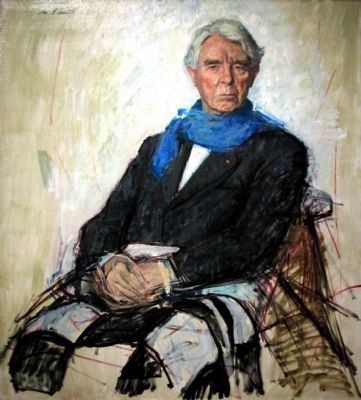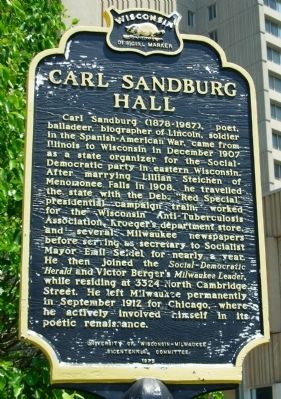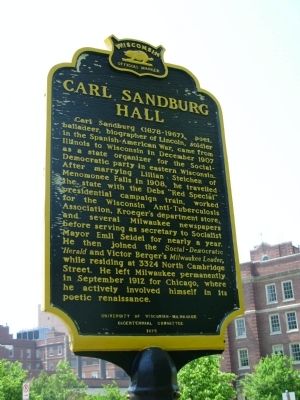Downer Woods in Milwaukee in Milwaukee County, Wisconsin — The American Midwest (Great Lakes)
Carl Sandburg Hall
Erected 1975 by University of Wisconsin - Milwaukee Bicentennial Committee. (Marker Number 206.)
Topics and series. This historical marker is listed in these topic lists: Arts, Letters, Music • Education • Railroads & Streetcars • Science & Medicine. In addition, it is included in the Wisconsin Historical Society series list. A significant historical month for this entry is September 1912.
Location. 43° 4.752′ N, 87° 52.941′ W. Marker is in Milwaukee, Wisconsin, in Milwaukee County. It is in Downer Woods. Marker is on Maryland Avenue, ¼ mile East Hartford Avenue, on the right when traveling north. Touch for map. Marker is at or near this postal address: 3400 North Maryland Avenue, Milwaukee WI 53211, United States of America. Touch for directions.
Other nearby markers. At least 8 other markers are within walking distance of this marker. Golda Meir (approx. 0.2 miles away); Milwaukee-Downer College Buildings (approx. 0.2 miles away); Milwaukee-Downer College (approx. ¼ mile away); The University of Wisconsin-Milwaukee (approx. 0.3 miles away); Lueddemann’s-On-The-River (approx. 0.4 miles away); Old Sauk Trail (approx. 0.6 miles away); Lake Park (approx. 0.6 miles away); Shorewood Village Hall (approx. 0.6 miles away). Touch for a list and map of all markers in Milwaukee.
Related markers. Click here for a list of markers that are related to this marker. To better understand the relationship, study each marker in the order shown.
Also see . . . Carl Sandburg Biography. (Submitted on July 8, 2010, by Bill Pfingsten of Bel Air, Maryland.)

Photographed By Allen C. Browne, November 2, 2011
5. Carl Sandburg
This 1961 portrait of Carl Sandburg by William A. Smith hangs in the National Portrait Gallery in Washington, DC.
“Perhaps no figure in American letters has ever identified himself more readily and affectionately with grassroots America than Carl Sandburg. From his poem ‘Chicago,’ hailing that city as ‘Hog Butcher to the World,’ to his efforts to preserve American folk music and his six-volume biography of Abraham Lincoln, Sandburg seemed forever dedicated to enriching popular appreciation for his country's democratic experience. In the 1930s, as the Depression steadily eroded the optimism that had always been an underpinning of that experience, he concluded that what the public most needed from him now was a reminder of the country's resilient virtues. By 1936, he had completed The People, Yes,, a long discourse in free verse admitting to America's failings but, more important, celebrating its overriding strengths. ‘A foreigner will find more of America’ in it, one critic wrote, ‘than in any other book.’” — National Portrait Galley
“Perhaps no figure in American letters has ever identified himself more readily and affectionately with grassroots America than Carl Sandburg. From his poem ‘Chicago,’ hailing that city as ‘Hog Butcher to the World,’ to his efforts to preserve American folk music and his six-volume biography of Abraham Lincoln, Sandburg seemed forever dedicated to enriching popular appreciation for his country's democratic experience. In the 1930s, as the Depression steadily eroded the optimism that had always been an underpinning of that experience, he concluded that what the public most needed from him now was a reminder of the country's resilient virtues. By 1936, he had completed The People, Yes,, a long discourse in free verse admitting to America's failings but, more important, celebrating its overriding strengths. ‘A foreigner will find more of America’ in it, one critic wrote, ‘than in any other book.’” — National Portrait Galley
Credits. This page was last revised on February 16, 2023. It was originally submitted on July 4, 2010, by Paul Fehrenbach of Germantown, Wisconsin. This page has been viewed 1,264 times since then and 48 times this year. Photos: 1, 2, 3, 4. submitted on July 4, 2010, by Paul Fehrenbach of Germantown, Wisconsin. 5. submitted on May 7, 2015, by Allen C. Browne of Silver Spring, Maryland. • Bill Pfingsten was the editor who published this page.



